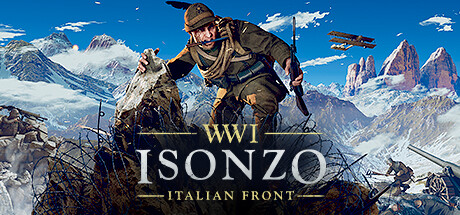In the Cycling Tour, we'll be exploring the area represented in the Montello map. There's a lot of history to be found here, from the very structures that played a role in this battle to the monuments erected in memory della Grande Guerra. Every friday we'll make a new stop at one of these historic locations until we arrive at our final destination: The Nervesa della Battaglia train station.
Previously: The Boys of '99 [#2]
https://store.steampowered.com/news/app/1556790/view/6468946777869867362
While heading to our next stop, the Monumento a Francesco Baracca, we're cycling through the beautiful landscape on Montello. Let's have a little intermission here, take a little break and talk a bit more about the history of Montello itself and a bit about the area as seen in-game.

Stop #3: Montello Hill
There's more to this hill than simply being "bean-shaped". It played a big role in the history of the region for as long as humans have lived in the area, so let's talk you through some of the highlights. We're not sticking to just WW1 this time!
Up until the Renaissance
Humanity's relationship with Montello goes back all the way to pre-historical times. Chipped stone points were found along the northern edge of Montello. These rudimentary stone tools were dated all the way back to the European Mesolithic era, dated roughly to 13,000-3,000 BC. It is assumed that these early inhabitants occupied the many caves that lead into Montello and exploited the river and forested area on the hill to sustain themselves.
Skipping ahead to the Classical Era, Montello and its surrounding region was settled by reformed soldiers of the Roman army. It's assumed a fortress was built on the site of current-day Nervesa della Battaglia, which was first documented as Nervisia in the year 954.
In 1062, the Abbey nearby was founded. This was the site where between 1550 and 1555, Giovanni Della Casa wrote Il Galateo. Known in English as Galateo: The Rules of Polite Behavior, this courtesy guide on how to behave in 'ordinary' social life during the Renaissance formed the very foundation used for modern etiquette used to this very day. It's likely to have influenced even Shakespeare's comedies.

Post-Renaissance to the 20th Century
Montello forms a large patch of oak & chestnut trees and is a major source of timber for the region. This is especially true for Venice, which used the timber procured from Montello for their shipyards and building foundations. In fact, it was so important to Venice that the Republic of Venice assumed ownership over the hill and declared it completely off-limits to the local population.
The residents, mostly hunters and woodsmen, were deprived of their homes and income. They became a class of "landless, homeless and jobless miserables", known as the Bisnenti ('twice have-nots'). They survived on odd jobs and crime but eventually emigrated in search of greener pastures in the Americas, France, Germany and Australia. Legislation was pushed to give Montello back to the Bisnenti in 1892, but the re-settlement and the damage from WW1 ruined the appeal of the woods for many.
 The Bisnenti are remembered with Le Scorrerie dei Bisnenti, a competition where contestants cut and transport timber. Source.
The Bisnenti are remembered with Le Scorrerie dei Bisnenti, a competition where contestants cut and transport timber. Source.Skipping WW1 for now (we'll get back to it, don't worry), we're going to 1930. In July this year, the Montello area was struck by an extremely violent tornado. While a tornado is quite rare in Europe to begin with, this specific one ranked F5 and is one of if not the strongest tornado ever recorded in Europe. With gusts of an estimate 400-500 km/h, this tornado caused extensive damage in its 132km long path from Casoni to Talmassons, killing at least 21.

Damage done to a church in Volpago del Montello
WW1 and Isonzo
Going slightly back in time, let's talk about WW1 again.
When the Austro-Hungarians pushed for Nervesa della Battaglia, they passed through the farms and woodlands on Montello, about where we're at with the tour right now. The first sector in-game is set around this area, where Italian artillery is set in a system of trenches. These trenches are quite unique: instead of planks, they weaved branches together to strengthen most of the sides.

Below are a couple more images of the woods, farms and vineyards on Montello as seen in Isonzo. War doesn't leave much nature intact, so it's not too surprising the Bisnenti weren't too interested in going back. It takes a lot of time and work to get a battlefield back to its old self, which may not always be worth it when the soil isn't that great to begin with.



Up next
Back to the present! Let's continue our cycle through the forests and the vineyards that occupy Montello in the current day. It's a beautiful area with lots of little roads and paths to explore – just be careful not to turn into any private roads.
 Photo supplied by Agli Zattieri.
Photo supplied by Agli Zattieri.Now, we're off to the Monumento a Francesco Baracca, for real this time. See you there!
 The route on Google Maps
The route on Google MapsVisit Montello!
The Montello Cycling Tour is a collaboration with local organizations. We'd like to thank them for helping us out with information about the region, the history and photos they provided. If you're interested in visiting the area, please check them out and tell them we sent you!
 |
For bike renting and a historic tour with possibility for a meal.Bike Rental Montellohttps://aglizattieri.com/ |
[/tr]
 |
Looking for your next holiday destination?Visit Prosecco Hillshttps://visitproseccohills.it/en |
[/tr]
 |
Want to learn more about WW1 and the history of the area?Museo della Battaglia di Vittorio VenetoLocation on Google Maps |
[/tr]
Follow our socials:
X / Twitter YouTube Discord Reddit
